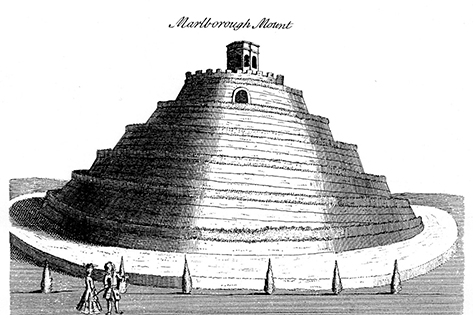The Wiltshire landscape around Avebury and Silbury Hill is at the heart of prehistoric Britain, and has World Heritage designation. Now another monument can be added to its archaeological treasures: the Marlborough Mound.
The Mound lies in the heart of the grounds of Marlborough College, and has long been recognised as a feature of considerable historical significance. It was the motte on which the keep of Marlborough Castle was built fifty years after the Norman Conquest, and is exceptionally large, standing over a hundred feet high. Its origins have until recently been obscure, with marginal evidence that it was prehistoric from finds made during building works in the early twentieth century.
In 2000 a trust was set up by Eric Elstob, who had been at the school in the 1950s, and had been intrigued by the neglected wilderness which the mound had become. Beginning in 2005, the Marlborough Mound Trust embarked on a major programme of rescue and restoration, as well as preliminary archaeological research. This was in progress when in 2010, English Heritage provided coring equipment for use on the mound, as they were anxious to compare its structure with the nearby World Heritage site at Silbury Hill, and this operation produced four samples of charcoal, allowing radiocarbon dating for the first time. The samples, which came from different levels in the Mound, were taken from two bore holes through the height of the 19m monument, and showed that it was built in the years around 2400 BC.
This is positive evidence that the motte is in fact a re-used prehistoric structure of the highest national standing, possibly unique among the Norman castles of the period. But the prehistoric mound itself is, in the words of Jim Leary, who led the recent archaeological investigations for English Heritage at the nearby Silbury Hill, “ an astonishing discovery. The Marlborough Mound has been one of the biggest mysteries in the Wessex landscape. For centuries people have wondered whether it is Silbury’s little sister; and now we have an answer. This is a very exciting time for British prehistory.”
The Trust has also funded research on the little-known medieval history of Marlborough Castle. We now know that this was a major royal residence in the thirteenth century, under both John and Henry III. Almost nothing remains of the castle, the keep of which was a ruin by 1400. Its history and appearance have to be reconstructed from archival records, but there is considerable material about its use by both kings, and by Henry’s queen, Eleanor of Provence.
The third phase of the mound’s history is as a feature in the grounds of the substantial house built next to it by the Seymour family, which survives as the focal point of the College’s main court. The garden contains a very fine early eighteenth century grotto, recently restored, cut into the base of the mound. The mound itself was given a spiral path and made into a viewing point: there is a fine bird’s-eye view of the garden made in 1729.
The mound itself is now cleared of the jungle of vegetation which obscured it, and the spiral path is fully restored, so that this extraordinary monument is at last visible in its eighteenth century form.

